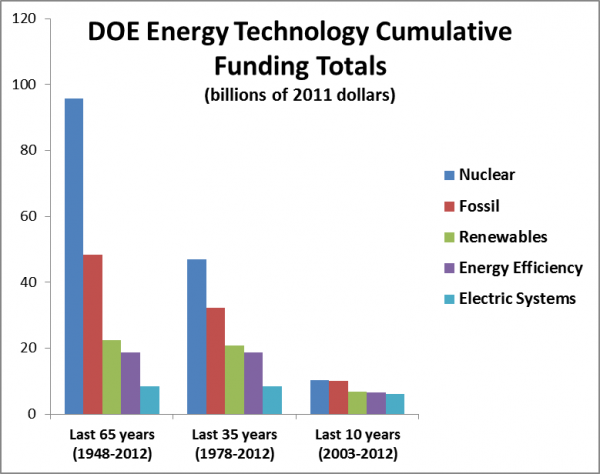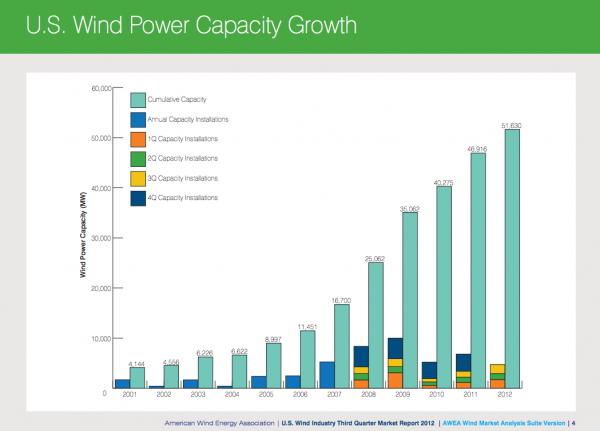In his State of the Union address, President Obama talked about the role research and development (R&D) has played to advance our society and enhance our quality of life. I think that most people would agree that keeping the lights on in a clean and safe manner is a core “quality of life” issue for all Americans. Yet, unless Congress reaches a budget deal by the end of the month, mandatory across-the-board funding cuts known as the sequester will kick in March 1. Given the important role R&D has played in advancing clean energy, I thought I’d lay out what’s at stake.
Historic (under)funding for clean energy research
 This post is part of a series on Ramping Up Renewables: Clean Energy Policies to Watch in 2013.
This post is part of a series on Ramping Up Renewables: Clean Energy Policies to Watch in 2013.
Subscribe to the series RSS feed.
After World War II, the U.S. government began to take a more active role funding research to develop new forms of energy and support economic growth. When the Department of Energy (DOE) was created in 1977, all of the energy funding was consolidated under its administration.
But, the the graph to the right shows that even in the last 35 years, as the country has been forced to come to grips with the public health and national security implications of relying on dirty and potentially unsafe fuel sources, funding renewables and energy efficiency were still lower priorities than funding fossil fuel or nuclear technologies.
However, the playing field has been somewhat leveled in the last 10 years, in large part to due to the focus on clean energy in the American Recovery and Reinvestment Act of 2009, otherwise known as the “stimulus bill.”

Data source: Table 1 from Sissine, F. (2012) “Renewable Energy R&D Funding History: A Comparison with Funding for Nuclear Energy, Fossil Energy, and Energy Efficiency R&D.” Congressional Research Service.
What we’ve achieved
By directing more of our investment dollars towards clean energy innovation, we’ve created vibrant, new markets for renewable energy technologies that can no longer be considered “alternative.”
Between 2007-2012, wind capacity nearly tripled and solar photovoltaic (PV) capacity grew by a factor of thirteen. Wind power was the fastest growing source of electricity generation capacity in 2012, beating even the growth in natural gas. Records amounts of solar (PV) were installed in 2011 and 2012. Today, there is enough solar power in the U.S. to supply over one million average American households.
These clean energy investments have helped significantly lower the price of renewable energy and benefited domestic manufacturing. The amount of made-in-the-USA equipment for wind farms grew from roughly 35 percent in 2006 to nearly 70 percent by 2011.
What’s at stake now
The Budget Control Act of 2011 capped the amount of federal discretionary spending, which includes almost all federal R&D, to remain essentially flat (accounting for inflation) over the next decade. This alone represents a decrease of about $1 trillion. If the across-the-board “sequester” cuts happen, the American Association for the Advancement of Science (AAAS), estimates that total R&D cuts would be at least $50 billion over the next 5 years.
Budgets for the National Science Foundation and the DOE, including programs at national labs and federally funded research at companies and universities, would be cut by $2.1 billion and $4.6 billion, respectively. These cuts could be even more extreme if Congress decides to shift more of the discretionary spending-reduction burden onto non-defense programs and away from defense programs.
In a letter DOE Secretary Steven Chu sent to senators earlier this month, he outlined specific implications of the cuts to clean energy progress, and warned that the looming sequester would “decelerate the nation’s transition into a clean energy economy, and could weaken efforts to become more energy independent and energy secure.”
It’s clear that avoiding sequestration will require a colossal effort on the part of the Obama administration and Congress, and would likely require finding alternative ways to achieve similar overall cost reductions. There is no easy path around our money problems. But, as Congress works to address these issues, it should consider the impacts of slashing R&D within the broader context of our historically lean budgets for clean energy, and how much further behind countries like China, South Korea, and Germany we will be if we turn our back now.

